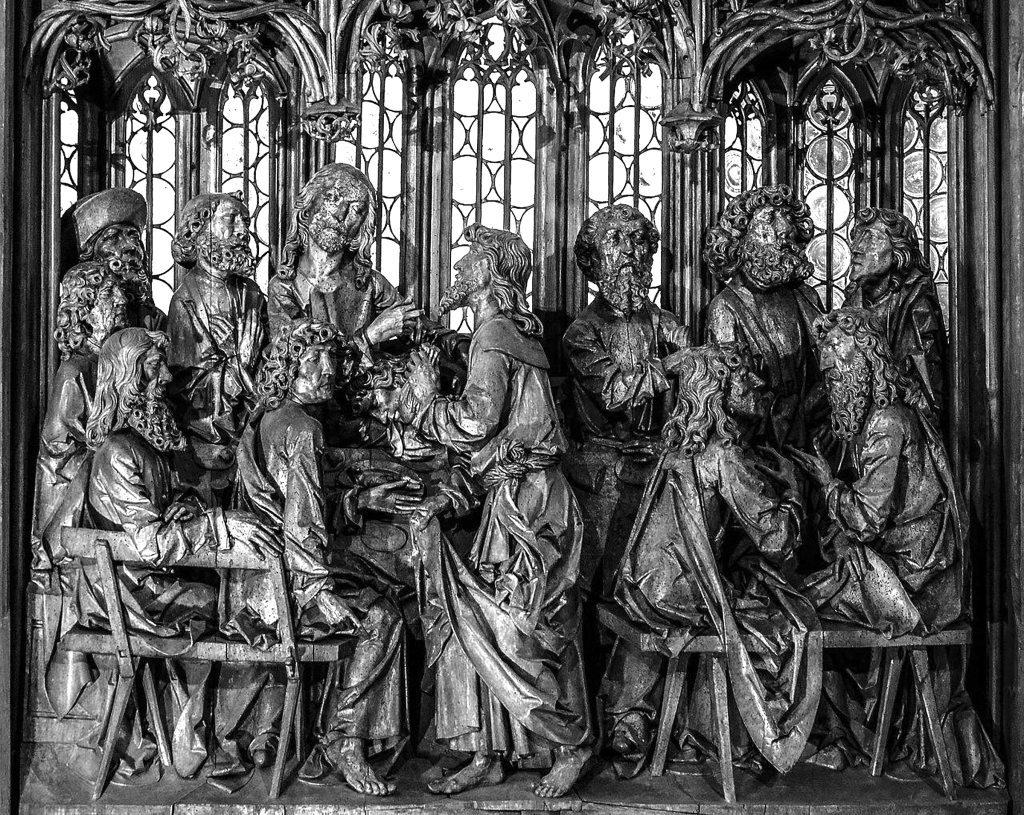
Life Sketches by Terry Berkson
Wood Carving Is Heart of Altarpiece
Set like a jewel in the heart of Saint Jacob’s Church in the walled city of Rothenburg, Germany, Tilman Riemenschneider’s lime wood altar carving of the Last Supper is an awesome sight to behold.
It was created in the latter part of the 15th century before Germany, as we know it today, existed. I learned about the altar and its creator when a German national friend treated me to an auto tour along the river Tauber, which flows past Rothenburg.
Riemenschneider worked in a Gothic style and produced figures whose faces clearly expressed sensitive, complex inner emotions. While looking at the altar you could almost hear Christ saying, “One of you will betray me.” The various “Not me!” expressions on the faces of the disciples are easy to read.
With representations of Riemenschneider’s work found in many churches in Germany and elsewhere, you would think that he lived a successful and celebrated life, but this was not the case.
The wood carver’s early work did, in fact, elevate his position in society. He eventually married a wealthy woman and for a time, as demand for his work increased, he was able to take on apprentices to aid with his productions. He even entered government as a councilman but unfortunately a peasant revolt broke out. When he refused to obey the Prince Bishop of Wurzburg’s orders to help quell the uprising, his fate changed drastically. Eventually the ill equipped peasant army was destroyed by a strong, well-armed aristocracy. Though defeated with thousands of lives lost, the peasants had carried out the largest rebellion in Europe prior to the French Revolution. Because he did not follow orders, Riemenschneider was stripped of his position and most of his possessions. He was thrown into jail and subjected to torture where it is believed his hands were broken.
When finally released from prison, the crippled sculptor could no longer express in wood his love for biblical stories and figures. Due to his injuries, few projects are attributed to him after his release. But he must have found some consolation in knowing that three of his biological sons—he had seven children—had inherited his talent and continued to produce works in wood. With the loss of social rank, the passage of time and in spite of his sons following in his footsteps, Riemenschneider was almost forgotten—until his gravestone was discovered next to a cathedral in Wurzburg (Germany) almost three centuries later. Subsequently, his work was recognized and reevaluated, resulting in a long overdue celebration of the artist.
Rothenburg is one of the three remaining walled towns in Europe and looks very much like it did at the time Riemenschneider carved the altar—except for damage done to paintings on inner walls of buildings where Napoleon, on one of his campaigns, had stored salt. Walking along the 20-foot-high wall or down the narrow cobblestone streets takes a visitor back more than 500 years. I shall forever be indebted to my friend for taking me on the trip and making me aware of the altar and the man who made it.
Terry Berkson’s articles have appeared in “New York” magazine, “Automobile” magazine and many others. His memoir, “Corvette Odyssey,” has received many good reviews: “highly recommended with broad appeal,” says “Library Journal.”

